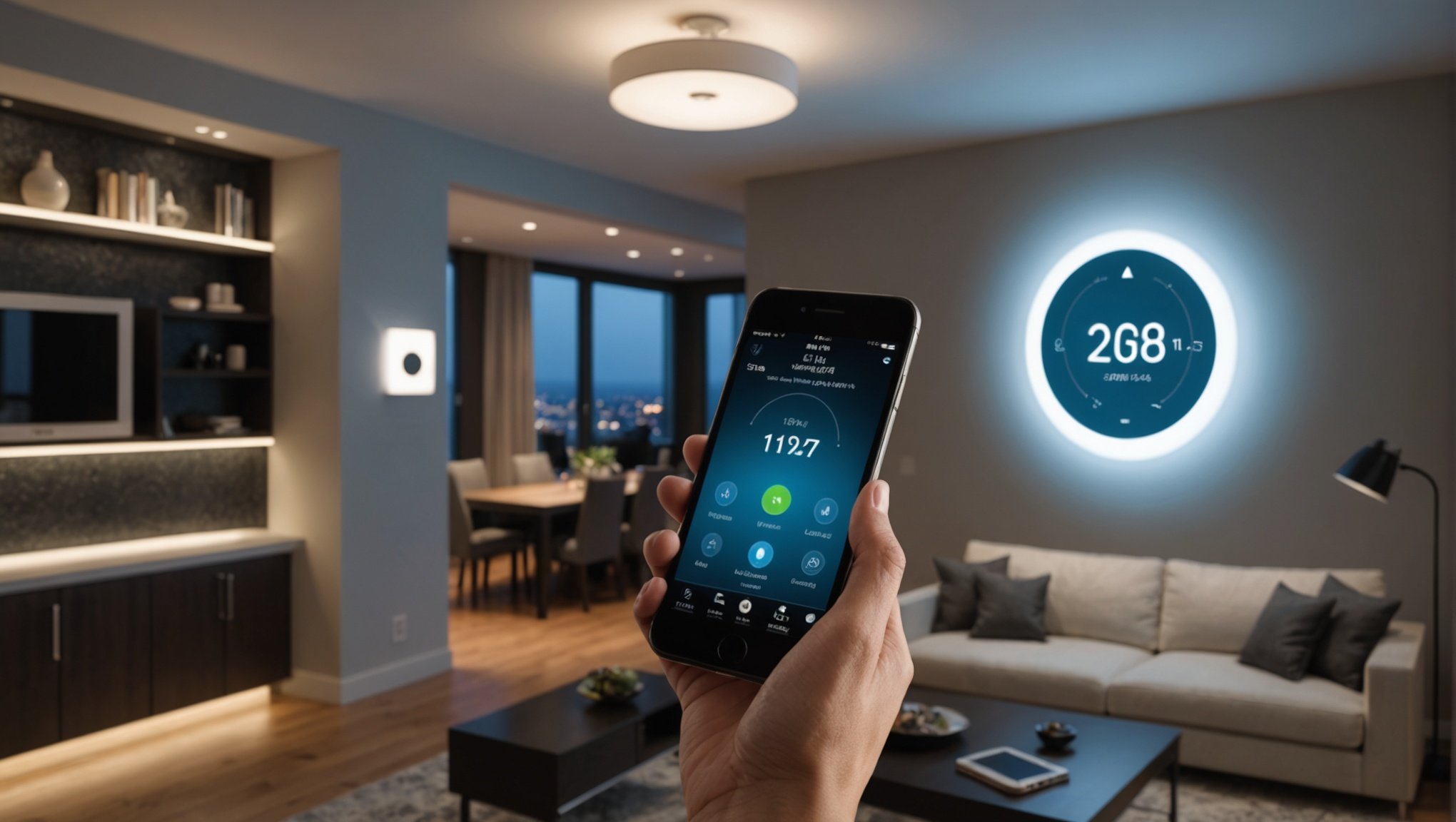Imagine effortlessly transforming your home’s atmosphere with just a few taps on your smartphone. Smart lighting control offers more than convenience; it enhances your living space's mood and functionality. From creating a cozy ambiance for movie night to brightening your workspace for productivity, mastering smart lighting can elevate your home life. Discover practical tips and innovative techniques that empower you to fine-tune every room's lighting to suit your style and needs seamlessly. Embrace the future of living as you learn to wield your smartphone like a pro.
Understanding Smart Lighting Systems
Smart lighting systems are revolutionising the way we illuminate our homes. These systems use advanced technology to offer greater control and flexibility over home lighting, enhancing both convenience and home ambiance. At the core of smart lighting technology is the integration of wireless connectivity, allowing users to control lights remotely using smartphones or voice-activated assistants.
In parallel : Maximize Your Productivity: Top Strategies for Efficiently Organizing Mobile Apps
The benefits of smart lighting extend beyond mere convenience. They offer the ability to customise lighting settings to suit different moods and activities, significantly improving home ambiance. For instance, you can adjust the brightness and colour temperature to create a relaxing atmosphere for a cosy evening or a vibrant setting for a lively gathering.
There are various types of smart lighting systems available, each catering to specific needs and preferences. Some popular options include smart bulbs, which can be easily integrated into existing fixtures, and smart switches, which allow for the control of traditional light fixtures. Additionally, there are comprehensive smart lighting kits that include multiple components for a fully automated experience. By choosing the right system, homeowners can enjoy a seamless blend of functionality and ambiance, enhancing their living spaces with ease.
Have you seen this : Mastering Your Smartphone: A Step-by-Step Guide to Controlling Your Smart Coffee Maker
Integrating Smart Lighting with Your Smartphone
Smartphone integration is a pivotal aspect of smart home technology, enabling seamless control over smart lighting systems. To connect smart lighting to your smartphone, follow these steps:
-
Download the recommended app: Most smart lighting systems come with a specific app. Popular choices include Philips Hue, LIFX, and Wyze. These apps are designed to provide intuitive control over your lighting.
-
Ensure compatibility: Before purchasing, verify that the smart lighting system is compatible with your smartphone. Most systems support both iOS and Android, but it's essential to double-check to avoid compatibility issues.
-
Connect to Wi-Fi: Ensure your smartphone and smart lighting system are on the same Wi-Fi network. This connection is crucial for effective communication between devices.
- Pair the devices: Open the app and follow the instructions to pair your smartphone with the smart lighting system. This process usually involves scanning a QR code or entering a unique code provided by the manufacturer.
By integrating smart lighting with your smartphone, you gain the ability to control the ambiance of your home effortlessly, enhancing your living environment with the touch of a button.
Setting Up Effective Lighting Schemes
Creating a well-designed lighting scheme is essential for enhancing your home design. By focusing on lighting schemes, you can transform your living space into a more inviting and functional environment.
Creating Mood with Colour Temperature
Understanding how to use colour temperature is key to setting the right mood. Warm white light, around 2700K, is perfect for creating a cosy and relaxing atmosphere, ideal for living rooms or bedrooms. In contrast, cooler white light, such as 4000K, is better suited for task-oriented areas like kitchens or home offices, where focus and alertness are needed.
Layering Light for Different Spaces
Effective lighting schemes involve layering different types of light. Ambient lighting provides overall illumination, while task lighting focuses on specific activities, such as reading or cooking. Accent lighting highlights architectural features or artwork. Combining these layers ensures each space is both functional and aesthetically pleasing.
Scheduling and Automation
Scheduling and automation can further enhance your home design by aligning lighting with your daily routines. Set lights to gradually brighten in the morning to simulate a natural sunrise, or dim them in the evening for a calming effect. For special occasions, pre-set scenes can create a festive or intimate atmosphere with minimal effort.
Recommended Smart Lighting Products
Navigating the world of smart lighting products can be overwhelming, given the plethora of options available. To help you make an informed decision, let's explore some top-rated smart bulbs and their features.
Top-Rated Smart Bulbs
-
Philips Hue: Known for its versatility and extensive range of colours, Philips Hue offers seamless integration with major smart home systems. It's a premium option, but its reliability and features justify the price.
-
LIFX: Offers vibrant colours and excellent brightness without the need for a hub. It's a strong contender for those seeking a straightforward and effective solution.
-
Wyze Bulb: Budget-friendly and easy to use, Wyze provides essential smart features without breaking the bank. It's ideal for those new to smart lighting.
Brand Comparison
When comparing smart lighting brands, consider compatibility, ease of use, and additional features like voice control. Philips Hue excels in compatibility, while LIFX offers superior brightness. Wyze is perfect for budget-conscious consumers.
Value for Money
Balancing budget-friendly and premium options depends on your needs. Premium brands like Philips Hue offer advanced features and integrations, whereas budget options like Wyze deliver essential functionality at a lower cost.
Troubleshooting Common Smart Lighting Issues
Navigating smart lighting problems can be frustrating, but many issues have straightforward solutions. Connectivity is a frequent challenge. If your smart lights lose connection, ensure your Wi-Fi network is stable and that your devices are within range. Sometimes, simply rebooting your router can resolve the issue.
Another common problem is app malfunction. If the app controlling your lights isn't responding, try closing and reopening it. Ensure your app and device firmware are up-to-date, as updates often fix bugs and improve functionality.
Synchronization problems between lights and apps can also occur. To tackle this, check that all devices are on the same network and that there are no pending updates. Re-pairing the devices can often solve synchronization issues.
For optimal performance, regular maintenance of your smart lighting system is crucial. Dust off bulbs and fixtures to ensure they function effectively. Additionally, periodically check for firmware updates from the manufacturer to keep your system running smoothly.
By understanding and addressing these common issues, you can enjoy a seamless smart lighting experience, enhancing your home's ambiance with minimal disruption.
Real-Life Examples of Smart Lighting in Action
Smart lighting is more than just a technological advancement; it's a catalyst for home transformation. Real-life smart lighting examples showcase its potential to revolutionise living spaces.
Consider the case of the Johnson family, who integrated smart lighting into their century-old home. By replacing traditional bulbs with smart ones, they transformed their dimly lit living room into a vibrant, adaptable space. The ability to adjust colour and intensity allowed them to create different moods for various occasions, from family movie nights to lively gatherings.
User testimonials highlight the profound impact of smart lighting. Sarah, a busy professional, shares how her smart lighting system has enhanced her daily routine. With automated schedules, her home greets her with a warm glow upon return, providing comfort and security.
Visual inspiration can be drawn from before-and-after setups. A previously stark kitchen can become a welcoming culinary haven with the addition of under-cabinet smart lighting. These smart lighting examples illustrate how technology can breathe new life into any home, offering both functional and aesthetic benefits.
Future Trends in Smart Lighting Technology
The smart lighting trends are evolving rapidly, with technology innovations paving the way for more sophisticated and efficient systems. One of the most exciting developments is the integration of Artificial Intelligence (AI) in smart lighting. AI enhances smart home lighting by enabling systems to learn user preferences and adjust lighting settings automatically. This means your home can anticipate your needs, adjusting brightness and colour based on your activities or time of day.
Upcoming innovations also include the development of energy-efficient smart bulbs that not only consume less power but also offer extended lifespans. These advancements contribute to a more sustainable living environment, aligning with global energy-saving goals.
Predictions for the future of home ambiance through smart technology are promising. We can expect lighting systems that seamlessly integrate with other smart home devices, creating a fully connected ecosystem. This integration will allow for more personalised and dynamic lighting experiences, enhancing comfort and convenience.
Smart lighting trends indicate a shift towards more intuitive and responsive systems, transforming how we interact with our living spaces. As technology continues to advance, the possibilities for creating customised home environments are virtually limitless.











